brakes FIAT DOBLO 2009 2.G Owners Manual
[x] Cancel search | Manufacturer: FIAT, Model Year: 2009, Model line: DOBLO, Model: FIAT DOBLO 2009 2.GPages: 274, PDF Size: 6.6 MB
Page 105 of 274
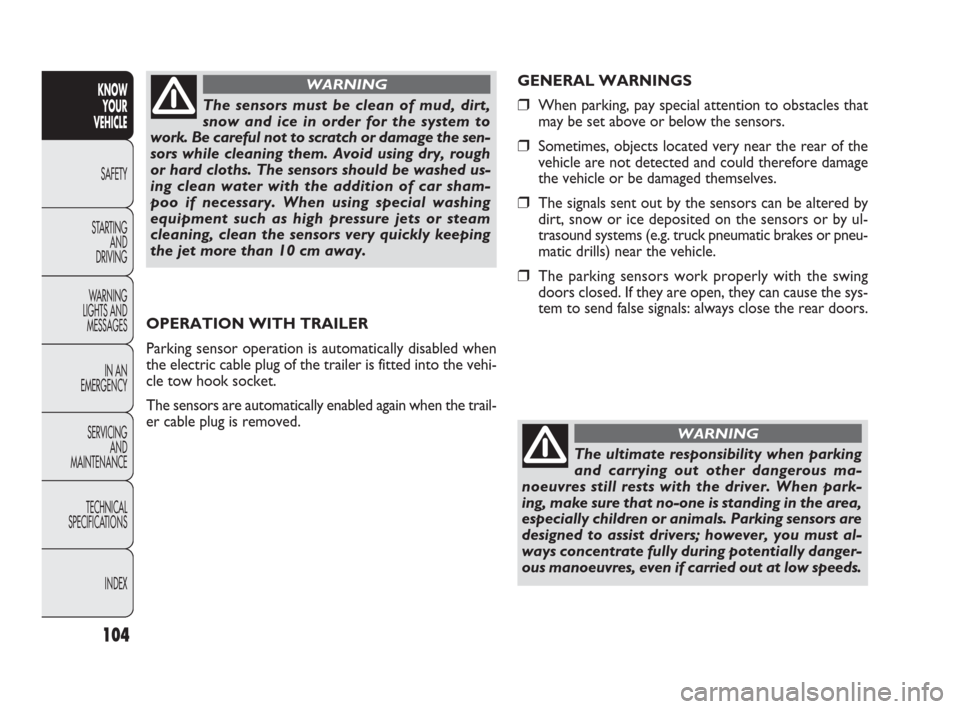
104
KNOW
YOUR
VEHICLE
SAFETY
STARTING
AND
DRIVING
WARNING
LIGHTS AND
MESSAGES
IN AN
EMERGENCY
SERVICING
AND
MAINTENANCE
TECHNICAL
SPECIFICATIONS
INDEX
GENERAL WARNINGS
❒When parking, pay special attention to obstacles that
may be set above or below the sensors.
❒Sometimes, objects located very near the rear of the
vehicle are not detected and could therefore damage
the vehicle or be damaged themselves.
❒The signals sent out by the sensors can be altered by
dirt, snow or ice deposited on the sensors or by ul-
trasound systems (e.g. truck pneumatic brakes or pneu-
matic drills) near the vehicle.
❒The parking sensors work properly with the swing
doors closed. If they are open, they can cause the sys-
tem to send false signals: always close the rear doors.
OPERATION WITH TRAILER
Parking sensor operation is automatically disabled when
the electric cable plug of the trailer is fitted into the vehi-
cle tow hook socket.
The sensors are automatically enabled again when the trail-
er cable plug is removed.
The sensors must be clean of mud, dirt,
snow and ice in order for the system to
work. Be careful not to scratch or damage the sen-
sors while cleaning them. Avoid using dry, rough
or hard cloths. The sensors should be washed us-
ing clean water with the addition of car sham-
poo if necessary. When using special washing
equipment such as high pressure jets or steam
cleaning, clean the sensors very quickly keeping
the jet more than 10 cm away.
WARNING
The ultimate responsibility when parking
and carrying out other dangerous ma-
noeuvres still rests with the driver. When park-
ing, make sure that no-one is standing in the area,
especially children or animals. Parking sensors are
designed to assist drivers; however, you must al-
ways concentrate fully during potentially danger-
ous manoeuvres, even if carried out at low speeds.
WARNING
Page 193 of 274

●●●●●●
●●●●●●
●●●●●●
●●●●●●
●●●●●●
●●●
●●●●●●
●●●●●●
●●
●●●
●●●●●●
●●●●●●
●●●●●●
192
KNOW
YOUR
VEHICLE
SAFETY
STARTING
AND
DRIVING
WARNING
LIGHTS AND
MESSAGES
IN AN
EMERGENCY
SERVICING
AND
MAINTENANCE
TECHNICAL
SPECIFICATIONS
INDEXSCHEDULED SERVICING PLAN
PETROL VERSIONS
Thousands of kilometres 30 60 90 120 150 180
Check tyre conditions/wear and adjust pressure if required
Check operation of lighting system (headlamps, direction indicators,
hazard warning lights, luggage compartment, passenger compartment,
glove compartment, instrument panel warning lights, etc.)
Check operation of windscreen washer/wipers,
adjust nozzles
Check position/wear of the windscreen wiper blades.
Check front disc brake pad conditions and wear
Check condition and wear of rear drum brake linings
Visually inspect the conditions of: bodywork,
underbody protection, pipes and tubes
(exhaust – fuel – brakes), rubber parts
(boots, sleeves, bushes, etc.)
Check cleanliness of bonnet and boot locks, as well as cleanliness
and lubrication of linkages
Visually inspect the condition of accessory drive belt(s).
Check tension of accessory drive belt(s)
(versions without automatic tensioner) (or every 24 months)
Check and, if necessary, adjust clutch pedal
Check the handbrake lever stroke and adjust it, if necessary.
Check exhaust gas emissions
Page 194 of 274

●●
●●●
●
●
●●●
●●●●●●
●●●●●●
●●●●●●
●●●●●●
●●●
●●●●●●
193
KNOW
YOUR
VEHICLE
SAFETY
STARTING
AND
DRIVING
WARNING
LIGHTS AND
MESSAGES
IN AN
EMERGENCY
SERVICING
AND
MAINTENANCE
TECHNICAL
SPECIFICATIONS
INDEXThousands of kilometres 30 60 90 120 150 180
Check condition of toothed timing belt
Replace spark plugs
Replace accessory drive belt(s)
Replace toothed timing belt
Replace air filter cartridge
Check and, if necessary, top up fluid levels (brakes/hydraulic
clutch, windscreen washer, battery, engine coolant, etc.)
Check engine management system operation
(through diagnostic socket)
Check cleanliness of sliding side door lower guides
(or every 6 months)
Change engine oil and replace oil filter (or every 24 months) (*)
Change brake fluid (or every 24 months)
Replace pollen filter (or every 24 months)
(*) If the vehicle is mainly driven in towns or clocks less than 10,000 km a year, the engine oil and filter should be changed every
12 months.
Page 195 of 274
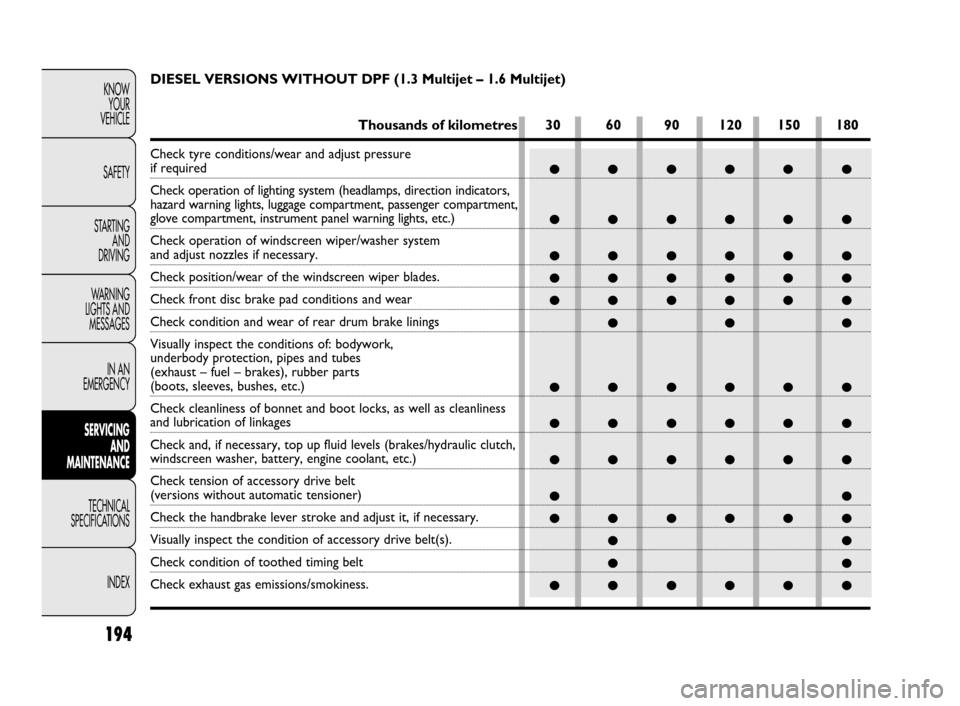
●●●●●●
●●●●●●
●●●●●●
●●●●●●
●●●●●●
●●●
●●●●●●
●●●●●●
●●●●●●
●●
●●●●●●
●●
●●
●●●●●●
194
KNOW
YOUR
VEHICLE
SAFETY
STARTING
AND
DRIVING
WARNING
LIGHTS AND
MESSAGES
IN AN
EMERGENCY
SERVICING
AND
MAINTENANCE
TECHNICAL
SPECIFICATIONS
INDEXDIESEL VERSIONS WITHOUT DPF (1.3 Multijet – 1.6 Multijet)
Thousands of kilometres 30 60 90 120 150 180
Check tyre conditions/wear and adjust pressure if required
Check operation of lighting system (headlamps, direction indicators,
hazard warning lights, luggage compartment, passenger compartment,
glove compartment, instrument panel warning lights, etc.)
Check operation of windscreen wiper/washer system
and adjust nozzles if necessary.
Check position/wear of the windscreen wiper blades.
Check front disc brake pad conditions and wear
Check condition and wear of rear drum brake linings
Visually inspect the conditions of: bodywork,
underbody protection, pipes and tubes
(exhaust – fuel – brakes), rubber parts
(boots, sleeves, bushes, etc.)
Check cleanliness of bonnet and boot locks, as well as cleanliness
and lubrication of linkages
Check and, if necessary, top up fluid levels (brakes/hydraulic clutch,
windscreen washer, battery, engine coolant, etc.)
Check tension of accessory drive belt
(versions without automatic tensioner)
Check the handbrake lever stroke and adjust it, if necessary.
Visually inspect the condition of accessory drive belt(s).
Check condition of toothed timing belt
Check exhaust gas emissions/smokiness.
Page 197 of 274
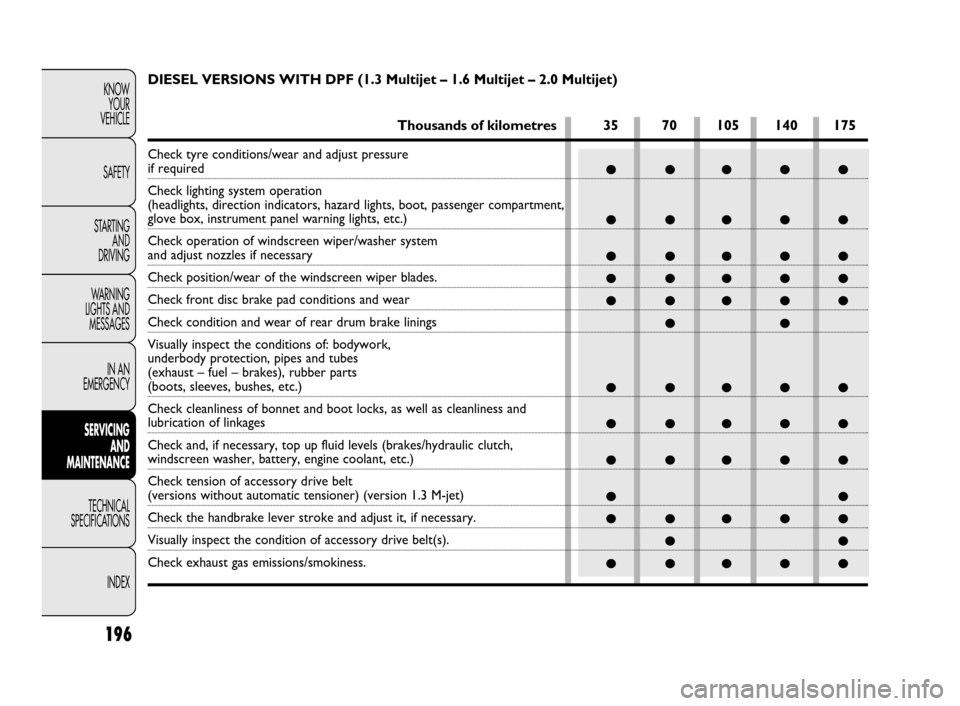
196
KNOW
YOUR
VEHICLE
SAFETY
STARTING
AND
DRIVING
WARNING
LIGHTS AND
MESSAGES
IN AN
EMERGENCY
SERVICING
AND
MAINTENANCE
TECHNICAL
SPECIFICATIONS
INDEX
● ●●●●
● ●●●●
● ●●●●
● ●●●●
● ●●●●
●●
● ●●●●
● ●●●●
● ●●●●
●●
● ●●●●
●●
● ●●●●
DIESEL VERSIONS WITH DPF (1.3 Multijet – 1.6 Multijet – 2.0 Multijet)
Thousands of kilometres 35 70 105 140 175
Check tyre conditions/wear and adjust pressure if required
Check lighting system operation
(headlights, direction indicators, hazard lights, boot, passenger compartment,
glove box, instrument panel warning lights, etc.)
Check operation of windscreen wiper/washer system
and adjust nozzles if necessary
Check position/wear of the windscreen wiper blades.
Check front disc brake pad conditions and wear
Check condition and wear of rear drum brake linings
Visually inspect the conditions of: bodywork,
underbody protection, pipes and tubes
(exhaust – fuel – brakes), rubber parts
(boots, sleeves, bushes, etc.)
Check cleanliness of bonnet and boot locks, as well as cleanliness and
lubrication of linkages
Check and, if necessary, top up fluid levels (brakes/hydraulic clutch,
windscreen washer, battery, engine coolant, etc.)
Check tension of accessory drive belt
(versions without automatic tensioner) (version 1.3 M-jet)
Check the handbrake lever stroke and adjust it, if necessary.
Visually inspect the condition of accessory drive belt(s).
Check exhaust gas emissions/smokiness.
Page 199 of 274
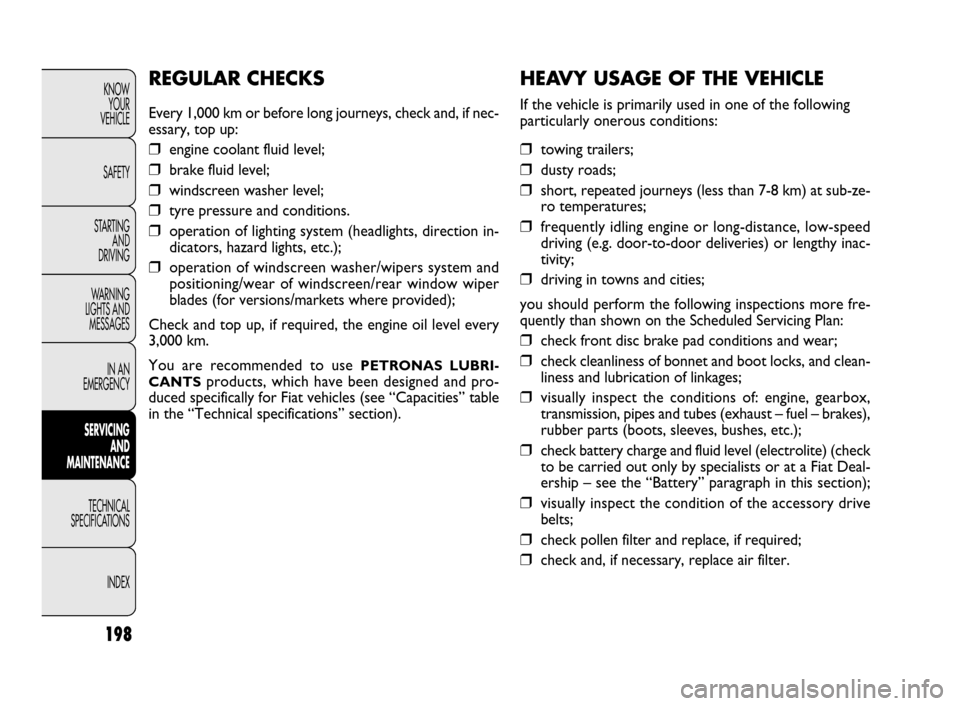
198
KNOW
YOUR
VEHICLE
SAFETY
STARTING
AND
DRIVING
WARNING
LIGHTS AND
MESSAGES
IN AN
EMERGENCY
SERVICING
AND
MAINTENANCE
TECHNICAL
SPECIFICATIONS
INDEXHEAVY USAGE OF THE VEHICLE
If the vehicle is primarily used in one of the following
particularly onerous conditions:
❒ towing trailers;
❒ dusty roads;
❒ short, repeated journeys (less than 7-8 km) at sub-ze-
ro temperatures;
❒ frequently idling engine or long-distance, low-speed
driving (e.g. door-to-door deliveries) or lengthy inac-
tivity;
❒ driving in towns and cities;
you should perform the following inspections more fre-
quently than shown on the Scheduled Servicing Plan:
❒ check front disc brake pad conditions and wear;
❒ check cleanliness of bonnet and boot locks, and clean-
liness and lubrication of linkages;
❒ visually inspect the conditions of: engine, gearbox,
transmission, pipes and tubes (exhaust – fuel – brakes),
rubber parts (boots, sleeves, bushes, etc.);
❒ check battery charge and fluid level (electrolite) (check
to be carried out only by specialists or at a Fiat Deal-
ership – see the “Battery” paragraph in this section);
❒ visually inspect the condition of the accessory drive
belts;
❒ check pollen filter and replace, if required;
❒ check and, if necessary, replace air filter.
REGULAR CHECKS
Every 1,000 km or before long journeys, check and, if nec-
essary, top up:
❒ engine coolant fluid level;
❒ brake fluid level;
❒ windscreen washer level;
❒ tyre pressure and conditions.
❒ operation of lighting system (headlights, direction in-
dicators, hazard lights, etc.);
❒ operation of windscreen washer/wipers system and
positioning/wear of windscreen/rear window wiper
blades (for versions/markets where provided);
Check and top up, if required, the engine oil level every
3,000 km.
You are recommended to use
PETRONAS LUBRI-
CANTS
products, which have been designed and pro-
duced specifically for Fiat vehicles (see “Capacities” table
in the “Technical specifications” section).
Page 226 of 274
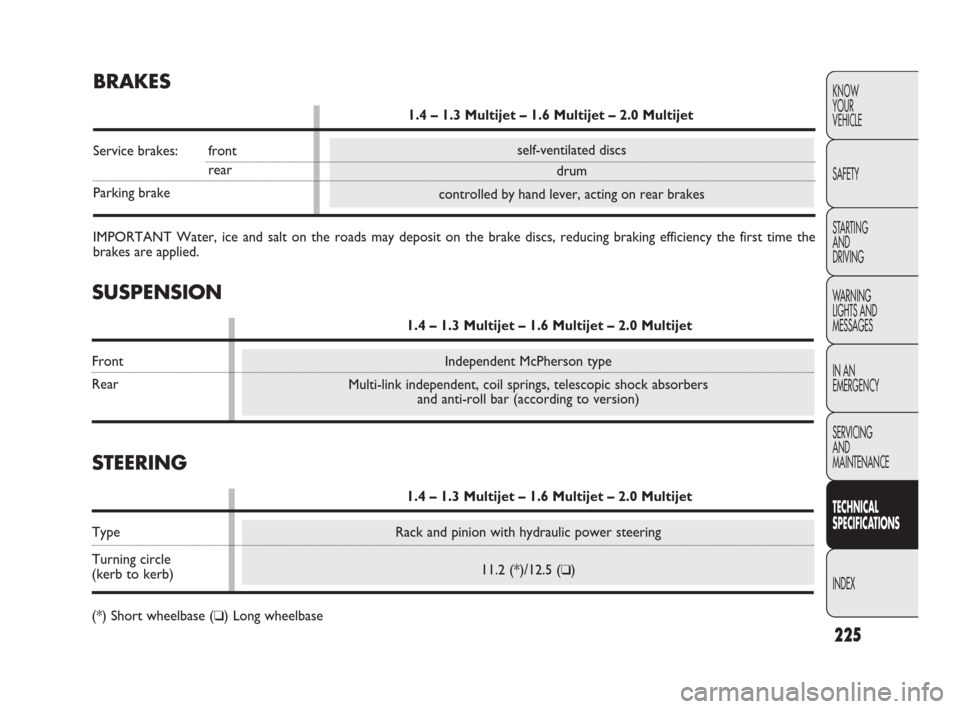
225
KNOW
YOUR
VEHICLE
SAFETY
STARTING
AND
DRIVING
WARNING
LIGHTS AND
MESSAGES
IN AN
EMERGENCY
SERVICING
AND
MAINTENANCE
TECHNICAL
SPECIFICATIONS
INDEX
Rack and pinion with hydraulic power steering
11.2 (*)/12.5 (
❑)
self-ventilated discs
drum
controlled by hand lever, acting on rear brakes
Independent McPherson type
Multi-link independent, coil springs, telescopic shock absorbers
and anti-roll bar (according to version)
BRAKES
1.4 – 1.3 Multijet – 1.6 Multijet – 2.0 Multijet
Service brakes: front
rear
Parking brake
IMPORTANT Water, ice and salt on the roads may deposit on the brake discs, reducing braking efficiency the first time the
brakes are applied.
SUSPENSION
1.4 – 1.3 Multijet – 1.6 Multijet – 2.0 Multijet
Front
Rear
STEERING
1.4 – 1.3 Multijet – 1.6 Multijet – 2.0 Multijet
Type
Turning circle
(kerb to kerb)
(*) Short wheelbase (
❑) Long wheelbase
Page 249 of 274

248
KNOW
YOUR
VEHICLE
SAFETY
STARTING
AND
DRIVING
WARNING
LIGHTS AND
MESSAGES
IN AN
EMERGENCY
SERVICING
AND
MAINTENANCE
TECHNICAL
SPECIFICATIONS
INDEX
Lubricants
and greases
for drive
transmission
system
Manual gearboxes
and mechanical
differentials
Manual
gearboxes and
mechanical differentials
Wheel side constant
velocity joints
Differential side
constant-velocity joints
Hydraulic power
steering
Hydraulic brakes
and hydraulic clutch
controls
Mixture:
50% water and
50% PARAFLU UP (❑)
To be mixed with diesel
(25 cc per 10 litres)
To be used diluted or
undiluted in
windscreen/rear window
washer/wiper systems Brake
fluid
Radiator
protection
Diesel
additive
Windscreen and
rear window
washer fluidTUTELA CAR
TECHNYX
Contractual Technical
Reference F010.B05
TUTELA CAR GEARTECH
Contractual Technical
Reference F704.C08
TUTELA ALL STAR
Contractual Technical
Reference F702.G07
TUTELA STAR 700
Contractual Technical
Reference F701.C07
TUTELA GI/R
Contractual Technical
Reference F428.H04
TUTELA TOP 4
Contractual Technical
Reference F001.A93
PARAFLU UP (
●)
Contractual Technical
Reference F101.M01
TUTELA DIESEL ART
Contractual Technical
Reference F601.L06
TUTELA
PROFESSIONAL SC 35
Contractual Technical
Reference F201.D02
SAE 75W-85 grade synthetic lubricant.
FIAT classification 9.55530- MX3.
SAE 75W-85 grade synthetic lubricant.
FIAT classification 9.55550-MZ3.
Molybdenum disulphide grease, for use at
high temperatures. Consistency NLGI 1-2.
FIAT classification 9.55580.
Grease for constant-velocity joints with low
friction coefficient. Consistency NLGI 0-1.
FIAT classification 9.55580.
Synthetic fluid for hydraulic
and electrohydraulic systems.
FIAT classification 9.55550- AG3.
Synthetic fluid, NHTSA n° 116 DOT 4, ISO 4925
SAE J-1704, CUNA NC 956- 01.
FIAT classification 9.55597.
Red protective with antifreeze action, based on
inhibited monoethyl glycol with organic
formula. Exceeds CUNA NC 956-16,
ASTM D 3306 specifications. FIAT classification 9.555323.
Additive for diesel antifreeze, protecting diesel engines
Mixture of spirits and surfactants.
Exceeds CUNA NC 956-11 specifications.
FIAT classification 9.55522.
Use Quality specifications of fluids and lubricants Genuine lubricants Applications for correct vehicle operation and fluids
(●) IMPORTANT Do not use fluids with different specifications for topping up or mixing.
(❑) When the vehicle is used in particularly harsh climate conditions, we recommend using a mixture of 60% PARAFLU UPand 40%
demineralised water.
Page 263 of 274
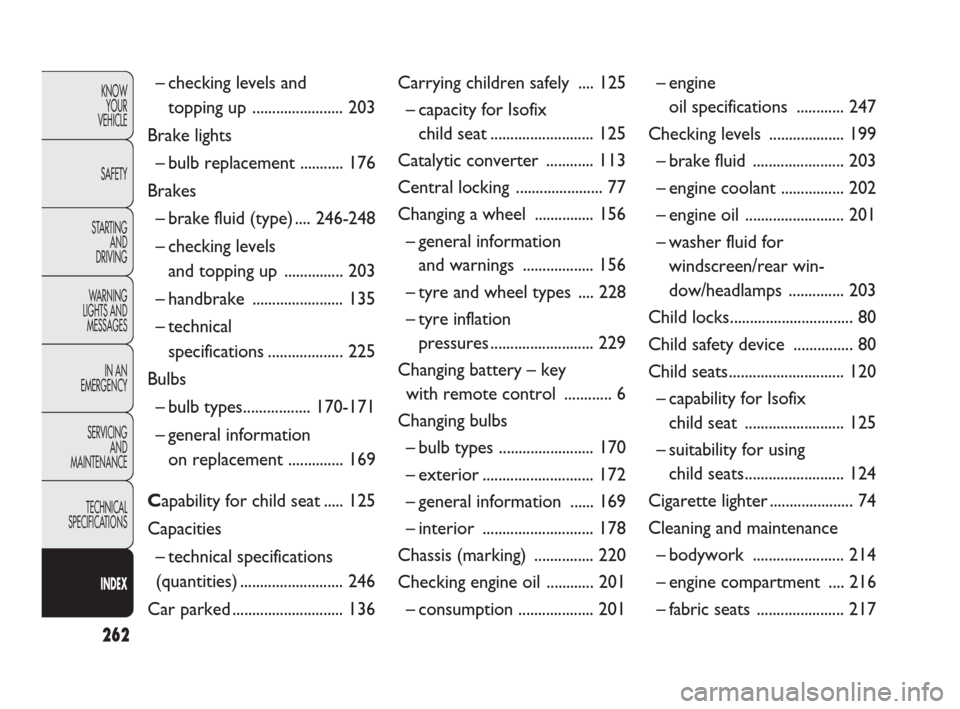
262
KNOW
YOUR
VEHICLE
SAFETY
STARTING
AND
DRIVING
WARNING
LIGHTS AND
MESSAGES
IN AN
EMERGENCY
SERVICING
AND
MAINTENANCE
TECHNICAL
SPECIFICATIONS
INDEX
– checking levels and
topping up ....................... 203
Brake lights
– bulb replacement ........... 176
Brakes
– brake fluid (type) .... 246-248
– checking levels
and topping up ............... 203
– handbrake ....................... 135
– technical
specifications................... 225
Bulbs
– bulb types.................170-171
– general information
on replacement .............. 169
Capability for child seat ..... 125
Capacities
– technical specifications
(quantities).......................... 246
Car parked ............................ 136Carrying children safely .... 125
– capacity for Isofix
child seat.......................... 125
Catalytic converter ............ 113
Central locking ...................... 77
Changing a wheel ............... 156
– general information
and warnings .................. 156
– tyre and wheel types .... 228
– tyre inflation
pressures.......................... 229
Changing battery – key
with remote control ............ 6
Changing bulbs
– bulb types ........................ 170
– exterior............................ 172
– general information ...... 169
– interior ............................ 178
Chassis (marking) ............... 220
Checking engine oil ............ 201
– consumption ................... 201– engine
oil specifications ............ 247
Checking levels ................... 199
– brake fluid ....................... 203
– engine coolant ................ 202
– engine oil ......................... 201
– washer fluid for
windscreen/rear win-
dow/headlamps .............. 203
Child locks............................... 80
Child safety device ............... 80
Child seats............................. 120
– capability for Isofix
child seat ......................... 125
– suitability for using
child seats......................... 124
Cigarette lighter..................... 74
Cleaning and maintenance
– bodywork ....................... 214
– engine compartment .... 216
– fabric seats ...................... 217